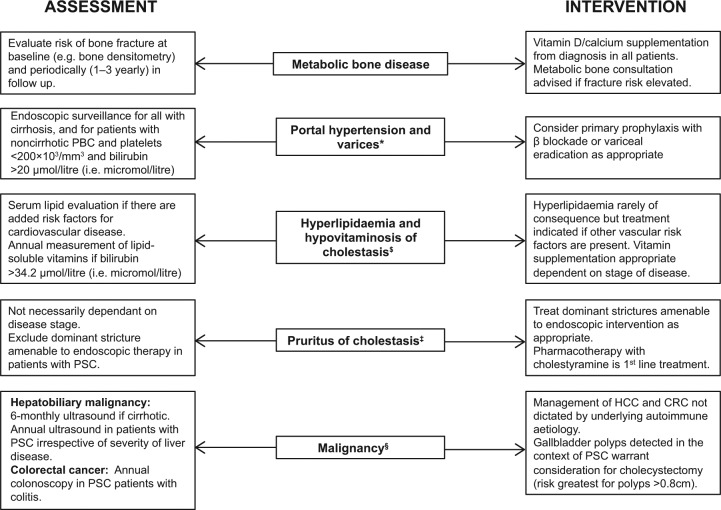Figure 1.
Extrahepatic manifestations, complications and surveillance strategies in autoimmune liver disease. The complete management of autoimmune liver disease should encompass early symptom recognition and surveillance of complications, whether they are related to the side effects from drug therapy (e.g. osteoporosis and prednisolone) or the underlying disease itself (e.g. metabolic osteopathy of cholestasis). Some complications may be evident only in patients with advanced fibrosis/cirrhosis [e.g. hepatocellular carcinoma (HCC)] whereas others are unrelated to disease severity [e.g. colonic cancer and biliary malignancies in primary sclerosing cholangitis (PSC); the pruritus of cholestasis].
*Obstruction to portal venous flow may also occur at a presinusoidal level in primary biliary cirrhosis (PBC), and nodular regenerative hyperplasia is found in up to 43%. Thus, given the risk of noncirrhotic portal hypertension in patients with PBC, additional parameters for variceal surveillance have been adopted [Bressler et al. 2005; Levy et al. 2007].
$Largely applies to PBC.
‡Cholestyramine is ineffective in around 20% of patients. Other bile-acid sequestrants (e.g. colesevelam) have not been shown to improve symptoms. Rifampicin use is supported by meta-analyses, although side effects remain a concern. Opioid antagonists can be used as a third-line treatment although there may be a risk of withdrawal-like reactions. Pilot studies report a subjective amelioration of itch using ondansetron and sertraline although patient numbers were small. Those with refractory pruritus can be treated with drugs having anecdotal support, or referred to specialized centres where more invasive or experimental approaches (e.g. extracorporeal albumin dialysis, ultraviolet B therapy) may be considered [Kremer et al. 2011].
§Effective surveillance strategies for cholangiocarcinoma (CCA) are currently lacking, although proteomic analysis of bile and urine could provide helpful as a future prospective [Lankisch et al. 2011; Metzger et al. 2013]. The risk of gallbladder cancer in PSC appears greatest with polyps over 0.8 cm [Eaton et al. 2012].

